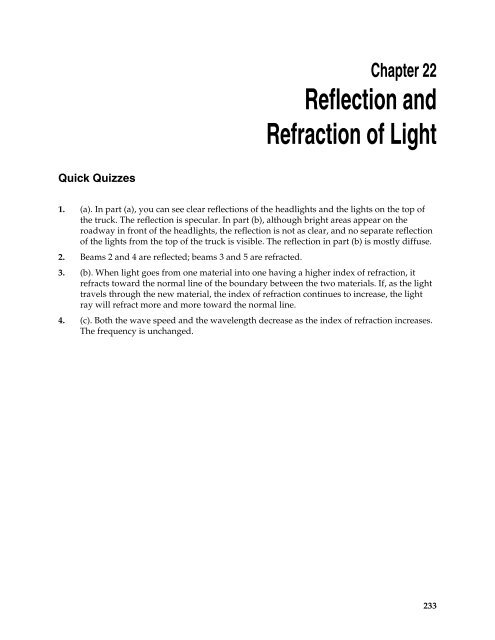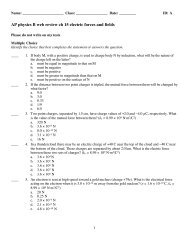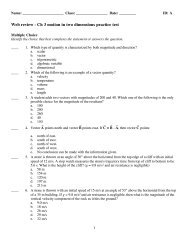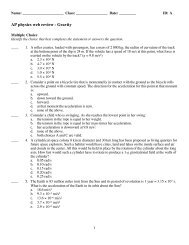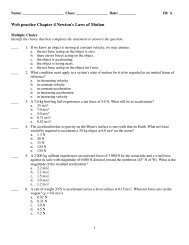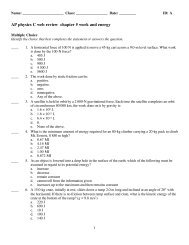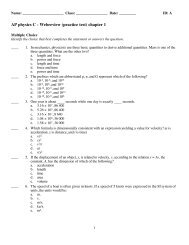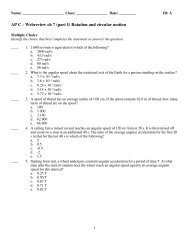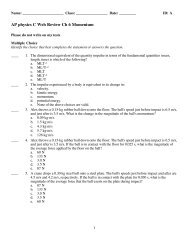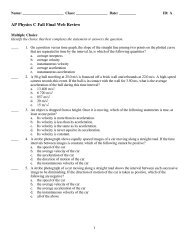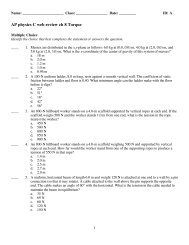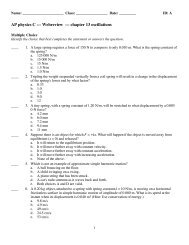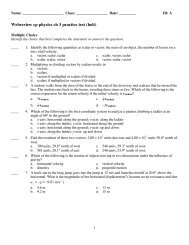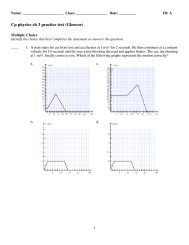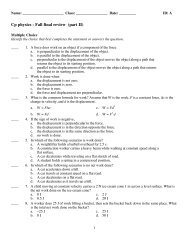Reflection and Refraction of Light
Chapter 22
Chapter 22
You also want an ePaper? Increase the reach of your titles
YUMPU automatically turns print PDFs into web optimized ePapers that Google loves.
Chapter 22<br />
<strong>Reflection</strong> <strong>and</strong><br />
<strong>Refraction</strong> <strong>of</strong> <strong>Light</strong><br />
Quick Quizzes<br />
1. (a). In part (a), you can see clear reflections <strong>of</strong> the headlights <strong>and</strong> the lights on the top <strong>of</strong><br />
the truck. The reflection is specular. In part (b), although bright areas appear on the<br />
roadway in front <strong>of</strong> the headlights, the reflection is not as clear, <strong>and</strong> no separate reflection<br />
<strong>of</strong> the lights from the top <strong>of</strong> the truck is visible. The reflection in part (b) is mostly diffuse.<br />
2. Beams 2 <strong>and</strong> 4 are reflected; beams 3 <strong>and</strong> 5 are refracted.<br />
3. (b). When light goes from one material into one having a higher index <strong>of</strong> refraction, it<br />
refracts toward the normal line <strong>of</strong> the boundary between the two materials. If, as the light<br />
travels through the new material, the index <strong>of</strong> refraction continues to increase, the light<br />
ray will refract more <strong>and</strong> more toward the normal line.<br />
4. (c). Both the wave speed <strong>and</strong> the wavelength decrease as the index <strong>of</strong> refraction increases.<br />
The frequency is unchanged.<br />
233
234 CHAPTER 22<br />
Answers to Even Numbered Conceptual Questions<br />
2. Ceilings are generally painted a light color so they will reflect more light, making the<br />
room brighter. Textured materials are <strong>of</strong>ten used on the ceiling to diffuse the reflected<br />
light <strong>and</strong> reduce glare (specular reflections).<br />
4. At the altitude <strong>of</strong> the plane the surface <strong>of</strong> Earth does not block <strong>of</strong>f the lower half <strong>of</strong> the<br />
rainbow. Thus, the full circle can be seen. You can see such a rainbow by climbing on a<br />
stepladder above a garden sprinkler in the middle <strong>of</strong> a sunny day.<br />
6. The spectrum <strong>of</strong> the light sent back to you from a drop at the top <strong>of</strong> the rainbow arrives<br />
such that the red light (deviated by an angle <strong>of</strong> 42°) strikes the eye while the violet light<br />
(deviated by 40°) passes over your head. Thus, the top <strong>of</strong> the rainbow looks red. At the<br />
bottom <strong>of</strong> the bow, violet light arrives at your eye <strong>and</strong> red light is deviated toward the<br />
ground. Thus, the bottom part <strong>of</strong> the bow appears violet.<br />
8. A mirage occurs when light changes direction as it moves between batches <strong>of</strong> air having<br />
different indices <strong>of</strong> refraction. The different indices <strong>of</strong> refraction occur because the air has<br />
different densities at different temperatures. Two images are seen; One from a direct path<br />
from the object to you, <strong>and</strong> the second arriving by rays originally heading toward Earth<br />
but refracted to your eye. On a hot day, the Sun makes the surface <strong>of</strong> blacktop hot, so the<br />
air is hot directly above it, becoming cooler as one moves higher into the sky. The “water”<br />
we see far in front <strong>of</strong> us is an image <strong>of</strong> the blue sky. Adding to the effect is the fact that the<br />
image shimmers as the air changes in temperature, giving the appearance <strong>of</strong> moving<br />
water.<br />
10. The upright image <strong>of</strong> the hill is formed by light that has followed a direct path from the<br />
hill to the eye <strong>of</strong> the observer. The second image is a result <strong>of</strong> refraction in the atmosphere.<br />
Some light is reflected from the hill toward the water. As this light passes through warmer<br />
layers <strong>of</strong> air directly above the water, it is refracted back up toward the eye <strong>of</strong> the<br />
observer, resulting in the observation <strong>of</strong> an inverted image <strong>of</strong> the hill directly below the<br />
upright image.<br />
12. The color traveling slowest is bent the most. Thus, X travels more slowly in the glass<br />
prism.<br />
14. Total internal reflection occurs only when light attempts to move from a medium <strong>of</strong> high<br />
index <strong>of</strong> refraction to a medium <strong>of</strong> lower index <strong>of</strong> refraction. Thus, light moving from air<br />
(n = 1) to water (n = 1.33) cannot undergo total internal reflection.<br />
16. Objects beneath the surface <strong>of</strong> water appear to be raised toward the surface by refraction.<br />
Thus, the bottom <strong>of</strong> the oar appears to be closer to the surface than it really is, <strong>and</strong> the oar<br />
looks to be bent.
<strong>Reflection</strong> <strong>and</strong> <strong>Refraction</strong> <strong>of</strong> <strong>Light</strong> 235<br />
18. The cross section can be visualized by considering just the two rays <strong>of</strong> light on the edges<br />
<strong>of</strong> the beam. If the beam <strong>of</strong> light enters a new medium with a higher index <strong>of</strong> refraction,<br />
the rays bend toward the normal, <strong>and</strong> the cross section <strong>of</strong> the refracted beam will be larger<br />
than that <strong>of</strong> the incident beam as suggested by Fig. CQ22.18a. If the new index <strong>of</strong><br />
refraction is lower, the rays bend away from the normal, <strong>and</strong> the cross section <strong>of</strong> the beam<br />
is reduced, as shown in Fig. CQ22.18b.<br />
1<br />
2<br />
n 2 > n 1<br />
1<br />
2<br />
n 2 < n 1<br />
(a)<br />
Figure CQ22.18<br />
(b)
236 CHAPTER 22<br />
Answers to Even Numbered Problems<br />
2.<br />
8<br />
2.97 × 10 m s<br />
4. (a) 536 rev s (b)<br />
3<br />
1.07 × 10 rev s<br />
6. (a) 1.94 m (b) 50.0° above horizontal (parallel to incident ray)<br />
8.<br />
−11<br />
2.09×<br />
10 s<br />
10. (a) The longer the wavelength, the less it is deviated (or refracted) from the original<br />
path.<br />
(b) Using data from Figure 22.14, the angles <strong>of</strong> refraction are:<br />
(400 nm) θ<br />
2<br />
= 16.0° , (500 nm) θ<br />
2<br />
= 16.1° , (650 nm) θ<br />
2<br />
= 16.3°<br />
12. (a) 327 nm (b) 287 nm<br />
14. 67.4°<br />
16. 53.4°<br />
18. First surface: θi<br />
= 30.0 ° , θ<br />
r<br />
= 19.5°<br />
Second surface: θ = 19.5 ° , θ = 30.0°<br />
i<br />
r<br />
20.<br />
−10<br />
1.06 × 10 s<br />
22. 107 m<br />
24. 6.30 cm<br />
26. 23.1°<br />
28. 2.5 m<br />
30. 0.40°<br />
32. 4.6°<br />
34. (a) 24.4° (b) 37.0°<br />
36. 48.5°<br />
38. 67.2°<br />
40. 4.54 m
<strong>Reflection</strong> <strong>and</strong> <strong>Refraction</strong> <strong>of</strong> <strong>Light</strong> 237<br />
44. (a) θ′ 1<br />
= 30.0 ° , θ2<br />
= 18.8° (b) θ′ 1<br />
= 30.0 ° , θ2<br />
= 50.8°<br />
(c) See solution.<br />
(d) See solution.<br />
46. (a) Any angle <strong>of</strong> incidence ≤ 90°<br />
(b) 30.0°<br />
(c) not possible since n < n<br />
polystyrene<br />
carbon disulfide<br />
48. (a) 0.172 mm s (b) 0.345 mm s<br />
(c) <strong>and</strong> (d) Northward at 50.0° below horizontal.<br />
50. 77.5°<br />
52. (a) R nd ( n 1)<br />
54. 7.91°<br />
56. 82<br />
58. 62.2% <strong>of</strong> a circle<br />
≥ − (b) yes; yes; yes (c) 350 µ m<br />
60. The graph is a straight line passing through the origin. From the slope <strong>of</strong> the graph,<br />
n = 1.33 .<br />
water<br />
2<br />
62. (a) ⎡ ( ) ⎤<br />
12<br />
n= 1+<br />
4t d<br />
⎣<br />
⎦<br />
(b) 2.10 cm<br />
(c) violet
238 CHAPTER 22<br />
Problem Solutions<br />
22.1 The total distance the light travels is<br />
⎛<br />
∆ d= 2⎜D −R −R<br />
⎝ center<br />
center to Earth Moon<br />
⎞<br />
⎟<br />
⎠<br />
8 6 6<br />
( )<br />
8<br />
= 2 3.84 × 10 − 6.38 × 10 − 1.76 × 10 m = 7.52×<br />
10 m<br />
Therefore,<br />
∆ d ×<br />
v = = = ×<br />
∆t<br />
2.51 s<br />
8<br />
7.52 10 m 3.00 10<br />
8 m s<br />
22.2 If the wheel has 360 teeth, it turns through an angle <strong>of</strong> 1 720 rev in the time it takes the<br />
light to make its round trip. From the definition <strong>of</strong> angular velocity, we see that the time<br />
is<br />
( ) −5<br />
θ 1720 rev<br />
t = = = 5.05 × 10 s<br />
ω 27.5 rev s<br />
Hence, the speed <strong>of</strong> light is<br />
( ) 8<br />
2d<br />
27500 m<br />
c = = = 2.97 × 10 m s<br />
−5<br />
t 5.05×<br />
10 s<br />
22.3 The experiment is most convincing if the wheel turns fast enough to pass outgoing light<br />
through one notch <strong>and</strong> returning light through the next. Then,<br />
⎛ 1 ⎞<br />
2π<br />
∆ θ = ⎜ rev ⎟( 2 π rad rev ) = rad<br />
⎝720 ⎠<br />
720<br />
<strong>and</strong><br />
8<br />
( ∆θ<br />
) ( × )<br />
3<br />
2( 11.45 10 m)<br />
∆θ ∆θ c 2.998 10 m s ⎛ 2π<br />
⎞<br />
ω = = = = ⎜ rad⎟=<br />
∆ t 2d c 2d<br />
× ⎝720<br />
⎠<br />
114 rad s
<strong>Reflection</strong> <strong>and</strong> <strong>Refraction</strong> <strong>of</strong> <strong>Light</strong> 239<br />
22.4 (a) The time for the light to travel to the stationary mirror <strong>and</strong> back is<br />
3<br />
( × )<br />
2d<br />
2 35.0 10 m<br />
∆ t = = = ×<br />
8<br />
c 3.00 × 10 m s<br />
−4<br />
2.33 10 s<br />
At the lowest angular speed, the octagonal mirror will have rotated 1 8 rev in this<br />
time, so<br />
ω<br />
∆θ<br />
18 rev<br />
= = =<br />
∆ t 2.33×<br />
10 s<br />
min −4<br />
536 rev s<br />
(b) At the next higher angular speed, the mirror will have rotated 28 rev in the<br />
elapsed time, or<br />
2 min<br />
( )<br />
3<br />
ω = 2ω<br />
= 2 536 rev s = 1.07 × 10 rev s<br />
22.5 (a) For the light beam to make it through both slots, the time for the light to travel<br />
distance d must equal the time for the disks to rotate through angle θ. Therefore, if c<br />
is the speed <strong>of</strong> light,<br />
d θ<br />
t = = , or<br />
c ω<br />
ω d<br />
c =<br />
θ<br />
(b) If d = 2. 500 m ,<br />
⎛ 1 ⎞⎛ 1 rev ⎞ 1 rev<br />
θ = ⎜ degree⎟⎜ ⎟=<br />
⎝60 ⎠⎝360 degree ⎠ 60 360<br />
( )( )<br />
( 60)( 360) 8<br />
rev<br />
c = ( 2.500 m)<br />
⎜ ⎛ 5 555 ⎟⎜ ⎞⎛ ⎟<br />
⎞ = 3.000 × 10 m s<br />
⎝ s ⎠⎝ 1 rev ⎠<br />
, <strong>and</strong> ω = 5 555 rev s
240 CHAPTER 22<br />
22.6<br />
Mirror<br />
2<br />
<strong>Light</strong><br />
beam<br />
Mirror 2<br />
50°<br />
1.25 m<br />
Mirror<br />
1<br />
40.0°<br />
P<br />
i 2 = 50°<br />
40° d<br />
40°<br />
i 1 = 40°<br />
50° 50°<br />
1.25 m Mirror 1<br />
(a) From geometry, 1.25 m = dsin 40.0° , so d = 1.94 m<br />
(b) 50.0 ° above horizontal , or parallel to the incident ray<br />
22.7 n1 sin θ1 = n2<br />
sin θ2<br />
q 1<br />
n 1 = 1.00<br />
sin θ<br />
1<br />
= 1.333 sin 45.0°<br />
sin θ = (1.333)(0.707)<br />
= 0.943<br />
1<br />
θ<br />
1<br />
= 70.5 ° → 19.5 ° above the horizontal<br />
n 2 = 1.333<br />
q 2<br />
c<br />
c<br />
22.8 The speed <strong>of</strong> light in water is vwater<br />
= , <strong>and</strong> in Lucite ® v<br />
Lucite<br />
=<br />
nwater<br />
n<br />
time required to transverse the double layer is<br />
Lucite<br />
. Thus, the total<br />
d d d n + d n<br />
∆ t1<br />
= + =<br />
v v c<br />
water Lucite water water Lucite Lucite<br />
water<br />
Lucite<br />
dwater<br />
+ dLucite<br />
The time to travel the same distance in air is ∆ t2<br />
= , so the additional time<br />
c<br />
required for the double layer is<br />
( − 1) + ( −1)<br />
d n d n<br />
∆ t=∆t1 −∆ t2<br />
=<br />
c<br />
water water Lucite Lucite<br />
−2 −2<br />
( 1.00 × 10 m)( 1.333 − 1) + ( 0.500 × 10 m)( 1.59 −1)<br />
= =<br />
×<br />
8<br />
3.00 10 m s<br />
×<br />
−11<br />
2.09 10 s
<strong>Reflection</strong> <strong>and</strong> <strong>Refraction</strong> <strong>of</strong> <strong>Light</strong> 241<br />
22.9 (a) From Snell’s law,<br />
n<br />
n sinθ<br />
( )<br />
1.00 sin 30.0°<br />
1 1<br />
2<br />
= = =<br />
sinθ2<br />
sin19.24°<br />
1.52<br />
λ0<br />
632.8 nm<br />
(b) λ<br />
2<br />
= = = 417 nm<br />
n 1.52<br />
2<br />
(c)<br />
(d)<br />
8<br />
c 3.00 × 10 m s<br />
14<br />
f = = = 4.74 × 10 Hz in air <strong>and</strong> in syrup<br />
−9<br />
λ0<br />
632.8 × 10 m<br />
c<br />
v<br />
2<br />
= =<br />
n<br />
2<br />
×<br />
8<br />
3.00 10 m s<br />
1.52<br />
= ×<br />
8<br />
1.98 10 m s<br />
n<br />
1<br />
= 1.00 into the<br />
Crown glass, Snell’s law gives the angle <strong>of</strong><br />
refraction as<br />
22.10 (a) When light refracts from air ( )<br />
⎛<br />
= ⎜ °<br />
⎝<br />
−1<br />
θ 2<br />
sin sin 25.0<br />
nCrown<br />
glass<br />
For first quadrant angles, the sine <strong>of</strong> the angle<br />
increases as the angle increases. Thus, from the<br />
above equation, note that θ<br />
2<br />
will increase when<br />
the index <strong>of</strong> refraction <strong>of</strong> the Crown glass<br />
decreases. From Figure 22.14, this means that<br />
the longer wavelengths have the largest angles<br />
<strong>of</strong> refraction, <strong>and</strong> deviate the least from the<br />
original path.<br />
⎞<br />
⎟<br />
⎠<br />
n<br />
1.54<br />
1.52<br />
1.50<br />
1.48<br />
1.46<br />
Crown glass<br />
Acrylic<br />
Fused quartz<br />
400 500 600 700<br />
l, nm<br />
(b) From Figure 22.14, observe that the index <strong>of</strong> refraction <strong>of</strong> Crown glass for the given<br />
wavelengths is:<br />
λ = 400 nm: n Crown glass<br />
= 1.53 ; λ = 500 nm: n Crown glass<br />
= 1.52 ;<br />
<strong>and</strong> λ = 650 nm: n Crown glass<br />
= 1.51<br />
Thus, Snell’s law gives: λ 400 nm: θ ( )<br />
λ 500 nm: θ ( )<br />
λ 650 nm: θ ( )<br />
=<br />
2<br />
= sin −1 sin 25.0° 1.53 = 16.0°<br />
=<br />
2<br />
= sin −1 sin 25.0° 1.52 = 16.1°<br />
=<br />
2<br />
= sin −1 sin 25.0° 1.51 = 16.3°
242 CHAPTER 22<br />
λ0<br />
22.11 (a)<br />
λ = , so λ λ ( )( )<br />
water<br />
n water<br />
0<br />
= = 1.333 438 nm = 584 nm<br />
n water water<br />
(b) λ0 = nwaterλwater = nbenzeneλbenzene<br />
<strong>and</strong><br />
n<br />
n<br />
benzene<br />
water<br />
λwater<br />
438 nm<br />
= = = 1.12<br />
λ 390 nm<br />
benzene<br />
λ0 436 nm<br />
22.12 (a) λ<br />
water<br />
= = = 327 nm<br />
1.333<br />
n water<br />
λ0 436 nm<br />
(b) λ<br />
glass<br />
= = = 287 nm<br />
n 1.52<br />
crown<br />
glass<br />
22.13 From Snell’s law,<br />
40.0° f<br />
( )<br />
−1⎡n1sinθ<br />
⎤<br />
1<br />
−1⎡<br />
1.00 sin 40.0°<br />
⎤<br />
θ2<br />
= sin ⎢ ⎥=<br />
sin ⎢ ⎥= 29.4°<br />
⎣ n2<br />
⎦ ⎣ 1.309 ⎦<br />
air<br />
ice<br />
a<br />
<strong>and</strong> from the law <strong>of</strong> reflection, φ = θ1 = 40.0°<br />
q 2<br />
Hence, the angle between the reflected <strong>and</strong> refracted rays is<br />
α = 180°−θ − φ = 180°− 29.4°− 40.0°= 111°<br />
2<br />
22.14 Snell’s law may be written as:<br />
sinθ<br />
sin<br />
n cv v<br />
n c v v<br />
2 1 1<br />
θ = = =<br />
1 2 2<br />
2<br />
1<br />
Thus,<br />
−1 v<br />
2<br />
−1<br />
1 510 m s<br />
θ2 = sin ⎡ ⎢ ⎛ sinθ1<br />
sin ⎡ sin12.0 ⎤<br />
⎜<br />
⎞<br />
⎟<br />
⎤ ⎥ = ⎢<br />
⎛ ⎜ ⎞<br />
⎟ ° ⎥ = 67.4°<br />
⎣⎢⎝v<br />
1 ⎠ ⎦⎥ ⎣⎢⎝ 340 m s ⎠ ⎦⎥<br />
22.15 The index <strong>of</strong> refraction <strong>of</strong> zircon is n = 1.923<br />
(a)<br />
c<br />
v = =<br />
n<br />
8<br />
3.00 × 10 m s<br />
1.923<br />
= ×<br />
8<br />
1.56 10 m s<br />
λ0 632.8 nm<br />
(b) The wavelength in the zircon is λ<br />
n<br />
= = = 329.1 nm<br />
n 1.923<br />
(c) The frequency is<br />
n<br />
0<br />
8<br />
3.00 × 10 m s<br />
v c<br />
f = = = = ×<br />
λ λ<br />
-9<br />
632.8 × 10 m<br />
14<br />
4.74 10 m s
<strong>Reflection</strong> <strong>and</strong> <strong>Refraction</strong> <strong>of</strong> <strong>Light</strong> 243<br />
22.16 The angle <strong>of</strong> incidence is<br />
− ⎡2.00 m⎤<br />
θ1<br />
= ⎢ =<br />
4.00 m ⎥<br />
⎣ ⎦<br />
1<br />
tan 26.6<br />
Therefore, Snell’s law gives<br />
°<br />
air<br />
water<br />
4.00 m<br />
q 2<br />
2.00<br />
m<br />
q 1<br />
q 1<br />
f<br />
θ<br />
−1 1 1<br />
2<br />
= sin ⎢ ⎥<br />
n2<br />
( )<br />
−1<br />
= = °<br />
sin<br />
⎡n<br />
sinθ<br />
⎤<br />
⎣<br />
⎦<br />
⎡ 1.333 sin 26.6°<br />
⎤<br />
⎢<br />
⎥<br />
⎣ 1.00 ⎦<br />
36.6<br />
<strong>and</strong> the angle the refracted ray makes with the surface is<br />
φ = 90.0°− θ = 90.0°− 36.6°= 53.4°<br />
2<br />
22.17 The incident light reaches the left-h<strong>and</strong> mirror at<br />
distance<br />
( 1.00 m)<br />
tan 5.00°=<br />
0.087 5 m<br />
above its bottom edge. The reflected light first<br />
reaches the right-h<strong>and</strong> mirror at height<br />
(<br />
2 0.087 5 m = 0.175 m<br />
)<br />
It bounces between the mirrors with this distance<br />
between points <strong>of</strong> contact with either.<br />
Mirror<br />
1.00 m<br />
reflected beam<br />
5.00°<br />
1.00 m<br />
Mirror<br />
Since<br />
1.00 m<br />
= 5.72 , the light reflects<br />
0.175 m<br />
five times from the right-h<strong>and</strong> m irror <strong>and</strong> six times from the left
244 CHAPTER 22<br />
22.18 At the first surface, the angle <strong>of</strong> incidence is θ<br />
1<br />
= 30.0° , <strong>and</strong> Snell’s law gives<br />
( )<br />
⎡n<br />
sinθ<br />
⎤ ⎡ 1.00 sin 30.0°<br />
⎤<br />
θ2<br />
= ⎢ ⎥= ⎢ ⎥=<br />
⎢⎣<br />
nglass<br />
⎥⎦<br />
⎣ 1.50 ⎦<br />
−1 air 1<br />
−1<br />
sin sin 19.5<br />
°<br />
Since the second surface is parallel to the first, the angle <strong>of</strong> incidence at the second<br />
surface is θ = 19.5° <strong>and</strong> the angle <strong>of</strong> refraction is<br />
1<br />
( )<br />
1 ss<br />
sinθ<br />
−<br />
⎡n gla glass ⎤<br />
−1⎡<br />
1.50 sin19.5°<br />
⎤<br />
θ2<br />
= sin ⎢ ⎥=<br />
sin ⎢ ⎥ = 30.0°<br />
⎣ n air ⎦ ⎣ 1.00 ⎦<br />
Thus, the light emerges traveling parallel to the incident beam.<br />
22.19 The angle <strong>of</strong> refraction at the first surface is θ<br />
2<br />
= 19.5° (see<br />
Problem 18). Let h represent the distance from point a to c<br />
(that is, the hypotenuse <strong>of</strong> triangle abc). Then,<br />
q 1<br />
a<br />
2.00 cm 2.00 cm<br />
h = = = 2.12 cm<br />
cosθ<br />
cos19.5°<br />
2<br />
Also, α = θ1 − θ2 = 30.0°− 19.5°= 10.5°<br />
, so<br />
(<br />
)<br />
d= hsinα<br />
= 2.12 cm sin10.5°= 0. 388 cm<br />
2.00 cm<br />
b<br />
q 1<br />
q 2<br />
c<br />
a<br />
d<br />
22.20 The distance h the light travels in the glass is<br />
2.00 cm<br />
h = = 2.12 cm<br />
cos 19.5°<br />
The speed <strong>of</strong> light in the glass is<br />
8<br />
c 3.00×<br />
10 m s<br />
v = = = ×<br />
n 1.50<br />
glass<br />
8<br />
2.00 10 m s<br />
Therefore,<br />
h ×<br />
t = = = ×<br />
v 2.00×<br />
10 m s<br />
−2<br />
2.12 10 m 10<br />
8 1.06 10<br />
− s
<strong>Reflection</strong> <strong>and</strong> <strong>Refraction</strong> <strong>of</strong> <strong>Light</strong> 245<br />
22.21 From Snell’s law, the angle <strong>of</strong> incidence at the air-oil interface is<br />
θ<br />
⎡n<br />
sinθ<br />
⎤<br />
−1<br />
oil oil<br />
= sin ⎢ ⎥<br />
nair<br />
⎣<br />
( )<br />
⎡ 1.48 sin 20.0°<br />
⎤<br />
= ⎢<br />
⎥=<br />
⎣ 1.00 ⎦<br />
−1<br />
sin 30.4<br />
⎦<br />
<strong>and</strong> the angle <strong>of</strong> refraction as the light enters the water is<br />
°<br />
( )<br />
−1⎡n<br />
sin<br />
1<br />
1.48 sin 20.0<br />
oil<br />
θ ⎤<br />
oil<br />
− ⎡<br />
° ⎤<br />
θ′ = sin ⎢ ⎥=<br />
sin ⎢ ⎥= 22.3°<br />
⎣ nwater<br />
⎦ ⎣ 1.333 ⎦<br />
22.22 The angle <strong>of</strong> incidence at the water<br />
surface is<br />
− ⎛90.0 m ⎞<br />
θ1<br />
= ⎜ ⎟=<br />
⎝ 100 m ⎠<br />
1<br />
tan 42.0<br />
Then, Snell’s law gives the angle <strong>of</strong><br />
refraction as<br />
θ<br />
⎛<br />
⎞<br />
1 nwater<br />
sinθ1<br />
1<br />
1.333 sin 42.0<br />
2<br />
= sin<br />
− ⎜ ⎟=<br />
sin<br />
− ⎜<br />
°<br />
nair<br />
1.00<br />
⎝<br />
⎠<br />
°<br />
h<br />
( )<br />
q 2<br />
210 m<br />
water<br />
n = 1.333<br />
⎛ ⎞<br />
⎟ = 63.1 °<br />
⎝<br />
⎠<br />
q 2<br />
air<br />
n = 1.00<br />
q 1<br />
90.0 m<br />
q 1<br />
Submarine<br />
100 m<br />
so the height <strong>of</strong> the building is<br />
210 m 210 m<br />
h = tanθ<br />
= tan63.1°<br />
=<br />
2<br />
107 m<br />
22.23 ∆ t = ( time to travel 6.20 m in ice) − ( time to travel 6.20 m in air)<br />
6.20 m 6.20 m<br />
∆ t = −<br />
v c<br />
ice<br />
Since the speed <strong>of</strong> light in a medium <strong>of</strong> refractive index n is<br />
c<br />
v =<br />
n<br />
( 6.20 m)( 0.309) −9<br />
⎛1.309<br />
1 ⎞<br />
∆ t = ( 6.20 m)<br />
⎜ − ⎟ = 6.39 10 s 6.39 ns<br />
8 = × =<br />
⎝ c c⎠<br />
3.00 × 10 m s
246 CHAPTER 22<br />
⎛n<br />
⎞<br />
medium<br />
22.24 From Snell’s law, sinθ<br />
= ⎜ ⎟sin 50.0°<br />
⎝ nliver<br />
⎠<br />
50.0°<br />
12.0 cm<br />
d<br />
n medium<br />
nmedium<br />
cvmedium<br />
vliver<br />
But, = = = 0.900<br />
n c v v<br />
liver liver medium<br />
h<br />
q<br />
q<br />
Tumor<br />
n liver<br />
so,<br />
−1<br />
θ = sin ⎡⎣( 0.900)<br />
sin 50.0°<br />
⎤⎦= 43.6°<br />
From the law <strong>of</strong> reflection,<br />
12.0 cm<br />
d = = 6.00 cm , <strong>and</strong><br />
2<br />
d 6.00 cm<br />
h = = =<br />
tanθ<br />
tan 43.6<br />
( ° )<br />
6.30 cm<br />
22.25 As shown at the right, θ1 + β + θ2 = 180°<br />
When β = 90°, this gives θ2 = 90°−<br />
θ1<br />
Then, from Snell’s law<br />
ng<br />
sinθ2<br />
sinθ1<br />
=<br />
n<br />
( θ )<br />
= n sin 90°− = n cosθ<br />
g<br />
air<br />
1 g 1<br />
incident<br />
ray<br />
Air,<br />
n = 1.00<br />
glass, n g<br />
q 1<br />
q 2<br />
q 1<br />
reflected<br />
ray<br />
b<br />
refracted<br />
ray<br />
sinθ1<br />
Thus, when β = 90°, cos<br />
tanθ1<br />
n g<br />
θ = = or tan −1<br />
θ = ( n )<br />
1 g<br />
1<br />
22.26<br />
Given Conditions <strong>and</strong> Observed Results<br />
Sheet 2<br />
26.5°<br />
n 2<br />
Case 1<br />
31.7°<br />
Sheet 1<br />
n 1<br />
26.5° Sheet 3<br />
n 3<br />
Sheet 2<br />
n 2 36.7°<br />
Sheet 3<br />
26.5°<br />
Case 2<br />
n 3<br />
Case 3<br />
q R<br />
Sheet 1<br />
n 1<br />
n1<br />
sin 26.5°<br />
For the first placement, Snell’s law gives, n2<br />
=<br />
sin 31.7°<br />
In the second placement, application <strong>of</strong> Snell’s law yields<br />
n<br />
⎛n<br />
sin 26.5°<br />
⎞<br />
n<br />
1<br />
sin 36.7°<br />
°= °= ⎜<br />
⎟ ° , or n<br />
3<br />
=<br />
⎝ sin 31.7°<br />
⎠<br />
sin 31.7°<br />
1<br />
3sin 26.5 n2sin 36.7 sin 36.7
<strong>Reflection</strong> <strong>and</strong> <strong>Refraction</strong> <strong>of</strong> <strong>Light</strong> 247<br />
Finally, using Snell’s law in the third placement gives<br />
n sin 26.5° ⎛ sin 31.7°<br />
⎞<br />
( n )<br />
1<br />
sinθR<br />
= =<br />
1<br />
sin 26.5° ⎜<br />
⎟=<br />
0.392<br />
n3 n1sin 36.7°<br />
<strong>and</strong> θ<br />
R<br />
= 23.1°<br />
⎝<br />
⎠<br />
22.27 When the Sun is 28.0° above the horizon, the angle <strong>of</strong><br />
incidence for sunlight at the air-water boundary is<br />
θ<br />
1<br />
= 90.0°− 28.0°= 62.0°<br />
Thus, the angle <strong>of</strong> refraction is<br />
28.0°<br />
h<br />
q 2<br />
q 1<br />
air, n = 1.00<br />
water<br />
n = 1.333<br />
θ<br />
⎡n<br />
−1 air 1<br />
2<br />
= sin ⎢ ⎥<br />
nwater<br />
⎣<br />
( )<br />
sinθ<br />
⎤<br />
⎡ 1.00 sin62.0°<br />
⎤<br />
= ⎢<br />
⎥=<br />
⎣ 1.333 ⎦<br />
−1<br />
sin 41.5<br />
⎦<br />
°<br />
3.00 m<br />
The depth <strong>of</strong> the tank is then<br />
3.00 m 3.00 m<br />
h = = =<br />
tanθ<br />
tan 41.5<br />
2<br />
( ° )<br />
3.39 m<br />
22.28 From the drawing, observe that<br />
R 1.5 m<br />
θ<br />
⎛ ⎞ ⎛ ⎞<br />
− −<br />
1<br />
= = ⎜ ⎟= °<br />
1 1<br />
tan ⎜ ⎟ tan 37<br />
⎝h1<br />
⎠ ⎝2.0 m ⎠<br />
Applying Snell’s law to the ray shown gives<br />
q 2<br />
d<br />
h 1<br />
q 1<br />
h 2<br />
R<br />
air<br />
n = 1.0<br />
liquid<br />
n = 1.5<br />
n<br />
1 liquid<br />
sinθ<br />
−<br />
⎛ 1 ⎞<br />
−1⎛1.5sin 37°<br />
⎞<br />
θ2<br />
= sin ⎜ ⎟=<br />
sin ⎜ ⎟= 64°<br />
⎝ nair<br />
⎠ ⎝ 1.0 ⎠<br />
Thus, the distance <strong>of</strong> the girl from the cistern is<br />
2 2<br />
( )<br />
d= h tanθ<br />
= 1.2 m tan64°=<br />
2.5 m
248 CHAPTER 22<br />
22.29 Using Snell’s law gives<br />
θ<br />
red<br />
( )<br />
−1⎛n<br />
sin<br />
1<br />
1.000 sin83.00<br />
air<br />
θ ⎞<br />
i<br />
− ⎛<br />
° ⎞<br />
= sin ⎜ ⎟= sin ⎜ ⎟=<br />
48.22°<br />
⎝ nred<br />
⎠ ⎝ 1.331 ⎠<br />
<strong>and</strong><br />
θ<br />
blue<br />
( )<br />
−1⎛n<br />
sin<br />
1<br />
1.000 sin83.00<br />
air<br />
θ ⎞<br />
i<br />
− ⎛<br />
° ⎞<br />
= sin ⎜ ⎟= sin ⎜ ⎟=<br />
47.79°<br />
⎝ nblue<br />
⎠ ⎝ 1.340 ⎠<br />
22.30 The angles <strong>of</strong> refraction for the two wavelengths are<br />
θ<br />
red<br />
( )<br />
1.00 0 sin 30.00<br />
−1 nair<br />
sinθi<br />
−1 = sin ⎛<br />
⎜ ⎞<br />
⎟= sin ⎛ ° ⎞<br />
= 18.04°<br />
n<br />
⎜<br />
red<br />
1.615 ⎟<br />
⎝ ⎠ ⎝ ⎠<br />
<strong>and</strong><br />
θ<br />
blue<br />
( )<br />
1.00 0 sin 30.00<br />
−1 nair<br />
sinθi<br />
−1 = sin ⎛<br />
⎜ ⎞<br />
⎟= sin ⎛ °<br />
⎞ = 17.64°<br />
n<br />
⎜<br />
blue<br />
1.650 ⎟<br />
⎝ ⎠ ⎝ ⎠<br />
Thus, the angle between the two refracted rays is<br />
∆ θ = θ − θ = 18.04°− 17.64°= 0.40°<br />
red<br />
blue<br />
22.31 (a) The angle <strong>of</strong> incidence at the first surface is<br />
θ<br />
1i<br />
= 30° , <strong>and</strong> the angle <strong>of</strong> refraction is<br />
n air = 1.0<br />
60°<br />
1 nair<br />
sinθ1i<br />
θ<br />
1r<br />
= sin<br />
⎛ − ⎞<br />
⎜ n ⎟<br />
⎝ glass ⎠<br />
q 1i = 30°<br />
a<br />
q 1r<br />
b<br />
q 2i<br />
q 2r<br />
− 1 ⎛1.0sin 30°<br />
⎞<br />
= si n ⎜ ⎟=<br />
19°<br />
⎝ 1.5 ⎠<br />
n glass = 1.5<br />
Also, α = 90°− θ = 71° <strong>and</strong> β = 180°− 60°− α = 49°<br />
1r<br />
Therefore, the angle <strong>of</strong> incidence at the second surface is θ2i = 90°− β = 41° . The<br />
angle <strong>of</strong> refraction at this surface is<br />
nglass<br />
sinθ<br />
−1⎛<br />
2i ⎞<br />
− 1⎛1.5sin 41°<br />
⎞<br />
θ 2r<br />
= sin<br />
⎜ ⎟= sin ⎜ ⎟= 77°<br />
⎝ nair<br />
⎠ ⎝ 1.0 ⎠
<strong>Reflection</strong> <strong>and</strong> <strong>Refraction</strong> <strong>of</strong> <strong>Light</strong> 249<br />
(b) The angle <strong>of</strong> reflection at each surface equals the angle <strong>of</strong> incidence at that surface.<br />
Thus,<br />
( θ )<br />
1<br />
θ1i 30<br />
reflection<br />
= = ° , <strong>and</strong> ( θ )<br />
2<br />
θ2i 41<br />
reflection<br />
= = °<br />
22.32 For the violet light, n = 1.66 , <strong>and</strong><br />
θ = sin<br />
1r<br />
−1<br />
glass<br />
⎛nair<br />
sinθ<br />
⎞<br />
1i<br />
⎜ n ⎟<br />
⎝ glass ⎠<br />
⎛1.00sin 50.0°<br />
⎞<br />
= ⎜<br />
⎟=<br />
⎝ 1.66 ⎠<br />
−1<br />
sin 27.5<br />
°<br />
q 1i = 50.0°<br />
n air = 1.00<br />
60.0°<br />
a b<br />
q 1r q 2i<br />
n glass<br />
q 2r<br />
α = 90°− θ = 62.5 ° , β = 180.0°−60.0°− α = 57.5 ° ,<br />
1r<br />
<strong>and</strong> θ2i = 90.0° − β = 32.5°<br />
. The final angle <strong>of</strong> refraction <strong>of</strong> the violet light is<br />
nglass<br />
sinθ<br />
−1⎛<br />
2i ⎞<br />
− 1⎛1.66sin 32.5°<br />
⎞<br />
θ2r<br />
= sin ⎜ ⎟=<br />
sin ⎜<br />
⎟= 63.2°<br />
⎝ nair<br />
⎠ ⎝ 1.00 ⎠<br />
Following the same steps for the red light ( n<br />
glass<br />
= 1.62)<br />
gives<br />
θ = 28.2 ° , α = 61.8 ° , β = 58.2 ° , θ = 31.8 ° , <strong>and</strong> θ = 58.6°<br />
1r 2i 2r<br />
Thus, the angular dispersion <strong>of</strong> the emerging light is<br />
Dispersion = θ −θ<br />
= 63.2°− 58.6°= 4.6°<br />
2r violet<br />
2r red<br />
22.33 When surrounded by air ( n<br />
2<br />
= 1.00) , the critical angle <strong>of</strong> a material is<br />
1⎛n<br />
⎞ ⎛ 1 1 ⎞<br />
− 2<br />
−<br />
θc<br />
= sin ⎜ ⎟=<br />
sin<br />
⎜ ⎟<br />
⎝ n1<br />
⎠ ⎝n material ⎠<br />
(a) For Zircon, n = 1.923 , <strong>and</strong><br />
(b) For fluorite, n = 1.434 , <strong>and</strong><br />
(c) For ice, n = 1.309 , <strong>and</strong><br />
θ c<br />
θ c<br />
θ c<br />
− ⎛ ⎞<br />
= sin ⎜ ⎟= 31.3°<br />
⎝1.923<br />
⎠<br />
1 1<br />
− ⎛ ⎞<br />
= sin ⎜ ⎟= 44.2°<br />
⎝1.434<br />
⎠<br />
1 1<br />
1 1<br />
− ⎛ ⎞<br />
= sin ⎜ ⎟= 49.8°<br />
⎝1.309<br />
⎠
250 CHAPTER 22<br />
22.34 When surrounded by air ( n<br />
2<br />
= 1.00) , the critical angle <strong>of</strong> a material is<br />
1⎛n<br />
⎞ ⎛ 1 1 ⎞<br />
− 2<br />
−<br />
θc<br />
= sin ⎜ ⎟=<br />
sin<br />
⎜ ⎟<br />
⎝ n1<br />
⎠ ⎝n material ⎠<br />
(a) For diamond, θ sin − ⎛ ⎞<br />
c<br />
= ⎜ ⎟=<br />
24.4°<br />
⎝2.419<br />
⎠<br />
(b) For flint glass,<br />
θ c<br />
1 1<br />
− ⎛ ⎞<br />
= sin ⎜ ⎟=<br />
37.0°<br />
⎝1.66<br />
⎠<br />
1 1<br />
22.35 When surrounded by water ( n<br />
2<br />
= 1.333)<br />
, the critical angle <strong>of</strong> a material is<br />
⎛n<br />
⎞<br />
θc<br />
= sin = sin<br />
⎝ ⎠<br />
⎛ 1.333 ⎞<br />
⎟<br />
⎝ ⎠<br />
−1 2<br />
−1<br />
⎜ ⎟ ⎜<br />
n1<br />
n material<br />
1 1.333<br />
(a) For diamond, θ sin − ⎛ ⎞<br />
c<br />
= ⎜ ⎟=<br />
33.4°<br />
⎝2.419<br />
⎠<br />
(b) For flint glass,<br />
θ c<br />
−1 ⎛1.333<br />
⎞<br />
= sin ⎜ ⎟=<br />
53.4°<br />
⎝ 1.66 ⎠<br />
22.36 Using Snell’s law, the index <strong>of</strong> refraction <strong>of</strong> the liquid is found to be<br />
n<br />
liquid<br />
( )<br />
n sin 1.00 sin 30.0<br />
air<br />
θ<br />
°<br />
i<br />
= = = 1.33<br />
sinθ<br />
sin 22.0°<br />
r<br />
Thus,<br />
⎛<br />
1 n ⎞<br />
− air<br />
−1⎛1.00<br />
⎞<br />
θc<br />
= sin = sin ⎜ ⎟=<br />
48.5°<br />
⎜n<br />
⎟<br />
⎝ liquid ⎠ ⎝1.33<br />
⎠<br />
22.37 When light attempts to cross a boundary from one medium <strong>of</strong> refractive index into a<br />
new medium <strong>of</strong> refractive index n < , total internal reflection will occur if the angle <strong>of</strong><br />
2<br />
n1<br />
−1<br />
incidence exceeds the critical angle given by θ c<br />
sin ( n n )<br />
= .<br />
2 1<br />
n 1<br />
(a) If<br />
− ⎛1.00<br />
⎞<br />
n = n = n = θ = ⎜ ⎟=<br />
⎝1.53<br />
⎠<br />
1<br />
1<br />
1.53 <strong>and</strong><br />
2 air<br />
1.00, then<br />
c<br />
sin 40.8°<br />
−1<br />
⎛1.333<br />
⎞<br />
(b) If n1 = 1.53 <strong>and</strong> n<br />
2<br />
= nwater<br />
= 1.333, then θc<br />
= sin ⎜ ⎟=<br />
60.6°<br />
⎝ 1.53 ⎠
<strong>Reflection</strong> <strong>and</strong> <strong>Refraction</strong> <strong>of</strong> <strong>Light</strong> 251<br />
22.38 The critical angle for this material in air is<br />
⎛<br />
1 n ⎞<br />
− air<br />
−1⎛1.00<br />
⎞<br />
θc<br />
= sin = sin ⎜ ⎟=<br />
47.3°<br />
⎜n<br />
⎟<br />
⎝ pipe ⎠ ⎝1.36<br />
⎠<br />
Thus, θ = 90.0°− θ = 42.7° <strong>and</strong> from Snell’s law,<br />
r<br />
c<br />
( )<br />
−1⎛npipe<br />
sinθr<br />
⎞<br />
− 1⎛<br />
1.36 sin 42.7°<br />
⎞<br />
θi<br />
= sin ⎜ ⎟= sin ⎜ ⎟= 67.2°<br />
⎝ nair<br />
⎠ ⎝ 1.00 ⎠<br />
q i<br />
q r<br />
q c<br />
22.39 The light must be totally reflecting from the surface <strong>of</strong> a hot air layer just above the road<br />
surface. The angle <strong>of</strong> reflection, <strong>and</strong> hence the critical angle, is θ<br />
c<br />
= 90.0°− 1.20°= 88.8°.<br />
n2<br />
Thus, from sinθ c<br />
=<br />
n<br />
1<br />
, we find<br />
n2 n1 θ c<br />
(<br />
)<br />
= sin = 1.000 3 sin88.8°=<br />
1.000 08<br />
22.40 The circular raft must cover the area <strong>of</strong> the surface<br />
through which light from the diamond could emerge.<br />
Thus, it must form the base <strong>of</strong> a cone (with apex at the<br />
diamond) whose half angle is θ, where θ is greater than<br />
or equal to the critical angle.<br />
q<br />
q h<br />
q<br />
r min<br />
q<br />
The critical angle at the water-air boundary is<br />
−1⎛ n ⎞<br />
air<br />
−1⎛ 1.00 ⎞<br />
θc<br />
= sin ⎜ ⎟= sin ⎜ ⎟=<br />
48.6°<br />
⎝nwater<br />
⎠ ⎝1.333<br />
⎠<br />
Thus, the minimum diameter <strong>of</strong> the raft is<br />
( )<br />
2r = 2htanθ<br />
= 2htanθ<br />
= 2 2.00 m tan 48.6°=<br />
4.54 m<br />
min min c
252 CHAPTER 22<br />
sinθ1<br />
v1<br />
22.41 (a) Snell’s law can be written as = . At the critical angle <strong>of</strong> incidence ( θ1 = θc<br />
),<br />
sinθ 2<br />
v2<br />
v1<br />
the angle <strong>of</strong> refraction is 90° <strong>and</strong> Snell’s law becomes sinθ c<br />
= . At the concrete-air<br />
v2<br />
boundary,<br />
− v<br />
− 343 m s<br />
θ = ⎛ ⎞ = ⎛ ⎞ =<br />
c<br />
1 1<br />
1<br />
sin ⎜ ⎟ sin ⎜ ⎟ 10.7<br />
⎝v2<br />
⎠ ⎝1 850 m s ⎠<br />
(b) Sound can be totally reflected only if it is initially traveling in the slower medium.<br />
Hence, at the concrete-air boundary, the sound must be traveling in air .<br />
°<br />
(c) S ound in air falling on the wall from most directions is 100% reflected , so the wall<br />
is a good mirror.<br />
22.42 The sketch at the right shows a light ray entering at the painted<br />
corner <strong>of</strong> the cube <strong>and</strong> striking the center <strong>of</strong> one <strong>of</strong> the three<br />
unpainted faces <strong>of</strong> the cube. The angle <strong>of</strong> incidence at this face<br />
is the angle θ<br />
1<br />
in the triangle shown. Note that one side <strong>of</strong> this<br />
triangle is half the diagonal <strong>of</strong> a face <strong>and</strong> is given by<br />
L<br />
q 1<br />
l<br />
l<br />
l<br />
2 2<br />
d l + l l<br />
= =<br />
2 2 2<br />
d¤2<br />
l<br />
Also, the hypotenuse <strong>of</strong> this triangle is<br />
2 2<br />
2 d<br />
2 l 3<br />
⎛ ⎞<br />
L = l + ⎜ ⎟ = l + = l<br />
⎝2⎠<br />
2<br />
2<br />
Thus,<br />
sin<br />
θ 1<br />
d 2 l 2 1<br />
= = =<br />
L l<br />
3<br />
( 3 2)<br />
For total internal reflection at this face, it is necessary that<br />
nair<br />
sinθ1<br />
≥ sinθc<br />
= or<br />
n<br />
cube<br />
1 1.00<br />
≥<br />
3 n<br />
giving n ≥ 3
<strong>Reflection</strong> <strong>and</strong> <strong>Refraction</strong> <strong>of</strong> <strong>Light</strong> 253<br />
22.43 If θ<br />
c<br />
= 42.0° at the boundary between the prism glass<br />
n2<br />
<strong>and</strong> the surrounding medium, then sinθ c<br />
= gives<br />
n<br />
or<br />
n<br />
n<br />
m<br />
glass<br />
= sin 42.0°<br />
nglass<br />
1<br />
= =1.494<br />
n sin 42.0°<br />
m<br />
1<br />
q 1<br />
q r<br />
Surrounding<br />
Medium, n m<br />
n glass b 60.0°<br />
q c = 42.0° a<br />
Surface 2<br />
From the geometry shown in the above figure,<br />
α = 90.0°−42.0°= 48.0 ° , β = 180°− 60.0°− α = 72.0°<br />
<strong>and</strong> θr<br />
= 90.0°− β = 18.0°. Thus, applying Snell’s law at the first surface gives<br />
⎛n<br />
sinθ<br />
⎞<br />
θ1<br />
= ⎜ ⎟=<br />
⎝ nm<br />
⎠<br />
( )<br />
−1 glass r<br />
−1<br />
sin sin 1.494 sin18.0 27.5<br />
° = °<br />
22.44 (a) θ′ 1<br />
= θ1 = 30.0°<br />
air<br />
q 1 q 1 ¢<br />
air<br />
q 2<br />
θ<br />
sin<br />
−1 1 1<br />
2<br />
= ⎜ ⎟<br />
n2<br />
sin<br />
( )<br />
−1<br />
= ⎜ ⎟<br />
= 18.8°<br />
⎛n<br />
sinθ<br />
⎞<br />
⎝<br />
⎛ 1.00 sin 30.0°<br />
⎞<br />
⎝<br />
⎠<br />
1.55<br />
⎠<br />
glass<br />
q 2<br />
Parts (a) <strong>and</strong> (c)<br />
glass<br />
q 1 q 1 ¢<br />
Parts (b) <strong>and</strong> (d)<br />
( )<br />
−1⎛n1sinθ<br />
⎞<br />
1<br />
−1⎛<br />
1.55 sin 30.0°<br />
⎞<br />
(b) θ′ 1<br />
= θ1<br />
= 30.0° , θ2<br />
= sin ⎜ ⎟= sin ⎜ ⎟=<br />
50.8°<br />
⎝ n2<br />
⎠ ⎝ 1.00 ⎠
254 CHAPTER 22<br />
(c) <strong>and</strong> (d) The other entries are computed similarly <strong>and</strong> are shown in the table below.<br />
(c) air into glass, angles in degrees<br />
(d) glass into air, angles in degrees<br />
incidence reflection refraction incidence reflection refraction<br />
0 0 0 0 0 0<br />
10.0 10.0 6.43 10.0 10.0 15.6<br />
20.0 20.0 12.7 20.0 20.0 32.0<br />
30.0 30.0 18.8 30.0 30.0 50.8<br />
40.0 40.0 24.5 40.0 40.0 85.1<br />
50.0 50.0 29.6 50.0 50.0 none*<br />
60.0 60.0 34.0 60.0 60.0 none*<br />
70.0 70.0 37.3 70.0 70.0 none*<br />
80.0 80.0 39.4 80.0 80.0 none*<br />
90.0 90.0 40.2 90.0 90.0 none*<br />
*total internal reflection<br />
22.45 At the air-ice boundary, Snell’s law gives the angle <strong>of</strong> refraction in the ice as<br />
−1⎛n<br />
sin<br />
1i<br />
1 ( 1.00)<br />
sin 30.0<br />
air<br />
θ ⎞<br />
− ⎛<br />
° ⎞<br />
θ1r<br />
= sin ⎜ ⎟=<br />
sin ⎜ ⎟= 22.5°<br />
⎝ nice<br />
⎠ ⎝ 1.309 ⎠<br />
Since the sides <strong>of</strong> the ice layer are parallel, the angle <strong>of</strong> incidence at the ice-water<br />
boundary is θ2i = θ1r = 22.5°. Then, from Snell’s law, the angle <strong>of</strong> refraction in the water<br />
is<br />
−1⎛n<br />
− 1 ( 1.309)<br />
sin 22.5°<br />
ice<br />
sinθ<br />
⎞<br />
2i<br />
⎛<br />
⎞<br />
θ2r<br />
= sin ⎜ ⎟= sin ⎜<br />
⎟=<br />
22.0°<br />
⎝ nwater<br />
⎠ ⎝ 1.333 ⎠<br />
22.46 (a) For polystyrene surrounded by air, total internal<br />
reflection at the left vertical face requires that<br />
q 1<br />
⎛n<br />
⎞ ⎛1.00<br />
⎞<br />
θ3<br />
≥ θc<br />
= = =<br />
⎜ n ⎟ ⎜ ⎟<br />
⎝ p ⎠ ⎝1.49<br />
⎠<br />
2 3<br />
−1 air<br />
−1<br />
sin sin 42.2<br />
From the geometry shown in the figure at the right,<br />
θ = 90.0°−θ<br />
≤ 90.0°− 42.2°= 47.8°<br />
°<br />
q 2<br />
q 2<br />
polystyrene<br />
n p = 1.49<br />
q 3<br />
q 3<br />
Thus, use <strong>of</strong> Snell’s law at the upper surface gives<br />
( )<br />
np<br />
sinθ2<br />
1.49 sin 47.8°<br />
sinθ1<br />
= ≤ = 1.10<br />
n<br />
1.00<br />
air<br />
so it is seen that any angle <strong>of</strong> incidence ≤ 90° at the upper surface will yield total<br />
internal reflection at the left vertical face.
<strong>Reflection</strong> <strong>and</strong> <strong>Refraction</strong> <strong>of</strong> <strong>Light</strong> 255<br />
(b) Repeating the steps <strong>of</strong> part (a) with the index <strong>of</strong> refraction <strong>of</strong> air replaced by that <strong>of</strong><br />
water yields θ3 ≥ 63.5°, θ2 ≤ 26.5°, sinθ1<br />
≤ 0.499 , <strong>and</strong> θ1 ≤ 30.0° .<br />
(c) Total internal reflection is not possible since npolystyrene<br />
< n<br />
carbon disulfide<br />
22.47 Applying Snell’s law at points A, B, <strong>and</strong> C, gives<br />
1.40sinα<br />
= 1.60sinθ<br />
(1)<br />
1<br />
1.20sin β = 1.40sinα<br />
(2)<br />
A<br />
B<br />
n = 1.60<br />
n = 1.40<br />
q 1<br />
a a b b<br />
<strong>and</strong> 1.00sinθ2<br />
= 1.20sin β<br />
(3)<br />
Combining equations (1), (2), <strong>and</strong> (3) yields<br />
n = 1.00 q 2<br />
n = 1.20<br />
C<br />
sinθ<br />
= 1.60sinθ<br />
(4)<br />
2 1<br />
Note that equation (4) is exactly what Snell’s law would yield if the second <strong>and</strong> third<br />
layers <strong>of</strong> this “s<strong>and</strong>wich” were ignored. This will always be true if the surfaces <strong>of</strong> all the<br />
layers are parallel to each other.<br />
(a) If<br />
1<br />
30.0<br />
−1<br />
θ = °, then equation (4) gives ( )<br />
θ 2<br />
= sin 1.60sin 30.0° = 53.1°<br />
(b) At the critical angle <strong>of</strong> incidence on the lowest surface, θ<br />
2<br />
= 90.0°. Then, equation (4)<br />
gives<br />
−1⎛sinθ2<br />
⎞ − 1⎛sin90.0°<br />
⎞<br />
θ1<br />
= sin ⎜ ⎟= sin ⎜ ⎟= 38.7°<br />
⎝ 1.60 ⎠ ⎝ 1.60 ⎠<br />
22.48 (a) We see the Sun swinging around a circle in the extended plane <strong>of</strong> our parallel <strong>of</strong><br />
latitude. Its angular speed is<br />
∆θ<br />
2 π rad<br />
ω = = = ×<br />
∆t<br />
86 400 s<br />
−5<br />
7.27 10 rad s<br />
The direction <strong>of</strong> sunlight crossing the cell from the window changes at this rate,<br />
moving on the opposite wall at speed<br />
−<br />
( )( )<br />
v= rω = × = × =<br />
5 −4<br />
2.37 m 7.27 10 rad s 1.72 10 m s 0.172 mm s
256 CHAPTER 22<br />
(b) The mirror folds into the cell the motion that would occur in a room twice as wide.<br />
Thus,<br />
−5<br />
( 2r) ω ⎡2( 2.37 m) ⎤( 7.27 10 rad s)<br />
v= = ⎣ ⎦ ×<br />
= ×<br />
−4<br />
3.45 10 m s = 0.345 mm s<br />
(c) <strong>and</strong> (d) As the Sun moves southward <strong>and</strong> upward at 50.0°, we may regard the<br />
corner <strong>of</strong> the window as fixed, <strong>and</strong> both patches <strong>of</strong> light move<br />
northward at 50.0 ° below the horizontal<br />
22.49 (a) From the geometry <strong>of</strong> the figure at<br />
the right, observe that θ<br />
1<br />
= 60.0° .<br />
Also, from the law <strong>of</strong> reflection,<br />
θ2 = θ1 = 60.0°. Therefore,<br />
α = 90.0°−θ2<br />
= 30.0°, <strong>and</strong><br />
θ3 + 90.0°=<br />
180 −α<br />
− 30.0° or<br />
θ<br />
3<br />
= 30.0°<br />
.<br />
60.0° P<br />
q 1<br />
Flint Glass<br />
n glass = 1.66<br />
n 2<br />
a<br />
q 2<br />
q 3<br />
30.0°<br />
n 2<br />
q 4<br />
Then, since the prism is immersed in<br />
water ( n<br />
2<br />
= 1.333 ) , Snell’s law gives<br />
n 2<br />
⎛n<br />
sin<br />
θ4 = sin ⎜ ⎟=<br />
sin<br />
⎝ n2<br />
⎠<br />
θ<br />
3 ⎞ ⎛( 1.66)<br />
sin 30.0°<br />
−1 glass<br />
−1<br />
⎜<br />
⎝<br />
1.333<br />
⎞<br />
⎟= 38.5°<br />
⎠<br />
(b) For refraction to occur at point P, it is necessary that θ > θ1<br />
.<br />
c<br />
Thus,<br />
θ<br />
sin<br />
⎛ n ⎞<br />
−<br />
> θ1<br />
, which gives<br />
⎝ ⎠<br />
1 2<br />
c<br />
= ⎜n<br />
⎟<br />
glass<br />
2 glass 1<br />
( )<br />
n > n sinθ<br />
= 1.66 sin60.0°=<br />
1.44
<strong>Reflection</strong> <strong>and</strong> <strong>Refraction</strong> <strong>of</strong> <strong>Light</strong> 257<br />
22.50 Applying Snell’s law to this refraction gives n sinθ2 = n sinθ1<br />
If θ1 = 2θ<br />
2<br />
, this becomes<br />
glass<br />
air<br />
( )<br />
n sinθ = sin 2θ = 2sinθ<br />
cosθ or cosθ<br />
2<br />
=<br />
glass 2 2 2 2<br />
Then, the angle <strong>of</strong> incidence is<br />
n glass<br />
2<br />
n<br />
−1⎛<br />
glass ⎞<br />
−1<br />
⎛1.56<br />
⎞<br />
θ1 = 2θ2<br />
= 2cos ⎜ ⎟=<br />
2cos ⎜ ⎟= 77.5°<br />
⎝ 2 ⎠ ⎝ 2 ⎠<br />
22.51 In the Figure at the right, observe that<br />
β = 90°− θ1<br />
<strong>and</strong> α = 90°− θ1<br />
. Thus,<br />
β = α .<br />
Similarly, on the right side <strong>of</strong> the<br />
prism, δ = 90° −θ2<br />
<strong>and</strong> γ = 90°− θ2<br />
,<br />
giving δ = γ .<br />
q 1<br />
b<br />
q 1<br />
q<br />
A<br />
2<br />
d<br />
q 2<br />
a<br />
q 1<br />
q 2<br />
g<br />
Next, observe that the angle between<br />
B<br />
the reflected rays is B = ( α + β) + ( γ + δ)<br />
,<br />
so B = 2( α + γ ) . Finally, observe that the<br />
left side <strong>of</strong> the prism is sloped at angle α from the vertical, <strong>and</strong> the right side is sloped at<br />
angle γ. Thus, the angle between the two sides is A = α + γ , <strong>and</strong> we obtain the result<br />
B= 2( α + γ)<br />
= 2A<br />
22.52 (a) Observe in the sketch at the right that a ray originally<br />
traveling along the inner edge will have the smallest angle<br />
<strong>of</strong> incidence when it strikes the outer edge <strong>of</strong> the fiber<br />
in the curve. Thus, if this ray is totally internally reflected,<br />
all <strong>of</strong> the others are also totally reflected.<br />
q<br />
d<br />
R<br />
For this ray to be totally internally reflected it is necessary<br />
that<br />
nair<br />
1<br />
θ ≥ θ c<br />
or sinθ<br />
≥ sinθc<br />
= =<br />
n n<br />
But, sinθ = R − d<br />
R<br />
, so we must have<br />
which simplifies to R≥nd ( n−<br />
1)<br />
pipe<br />
R− d 1 ≥<br />
R n<br />
R – d
258 CHAPTER 22<br />
(b) As d →0, R→0<br />
. This is reasonable behavior.<br />
As n increases,<br />
nd<br />
n−<br />
Rmi<br />
n<br />
= =<br />
1 1 1<br />
As n → 1 , R increases. This is<br />
min<br />
d<br />
decreases. This is reasonable behavior.<br />
− n<br />
reasonable behavior.<br />
(c)<br />
( 1.40)( 100 µ m)<br />
nd<br />
R<br />
min<br />
= =<br />
n −1 1.40−1<br />
=<br />
350 µ m<br />
22.53 Consider light from the bottom end <strong>of</strong> the wire that<br />
happens to be headed up along the surface <strong>of</strong> the wire<br />
before <strong>and</strong> after refraction with angle <strong>of</strong> incidence θ 1 <strong>and</strong><br />
angle <strong>of</strong> refraction θ<br />
2<br />
= 60.0°. Then, from Snell’s law, the<br />
angle <strong>of</strong> incidence was<br />
q 2<br />
30.0°<br />
Air<br />
benzene<br />
q<br />
q 1<br />
θ = sin<br />
1<br />
−1<br />
⎛nair<br />
sinθ<br />
⎞<br />
2<br />
⎜ ⎟<br />
⎝ nbenzene<br />
⎠<br />
( )<br />
⎛ 1.00 sin60.0°<br />
⎞<br />
= ⎜<br />
⎟=<br />
⎝ 1.50 ⎠<br />
−1<br />
sin 35.3<br />
Thus, the wire is bent by angle θ = 60.0°− θ1<br />
= 60.0°− 35.3°= 24.7°<br />
°
<strong>Reflection</strong> <strong>and</strong> <strong>Refraction</strong> <strong>of</strong> <strong>Light</strong> 259<br />
22.54 From the sketch at the right, observe that<br />
the angle <strong>of</strong> incidence at A is the same as<br />
the prism angle at point O. Given that<br />
θ = 60.0°, application <strong>of</strong> Snell’s law at<br />
point A gives<br />
( )<br />
1.50sin β = 1.00 sin60.0° or β = 35.3°<br />
From triangle AOB, we calculate the<br />
angle <strong>of</strong> incidence <strong>and</strong> reflection, γ , at<br />
point B:<br />
f<br />
q<br />
C<br />
A<br />
b<br />
g g d<br />
q<br />
90.0° – q<br />
O B Q<br />
( β) ( )<br />
θ + 90.0°− + 90.0°− γ = 180° or γ = θ − β = 60.0°− 35.3°= 24.7°<br />
Now, we find the angle <strong>of</strong> incidence at point C using triangle BCQ:<br />
( °− γ ) + ( °−δ) ( θ)<br />
90.0 90.0 + 90.0°− = 180°<br />
or δ ( θ γ)<br />
= 90.0°− + = 90.0°− 84.7°<br />
= 5.26°<br />
Finally, application <strong>of</strong> Snell’s law at point C gives ( 1.00) sinφ = ( 1.50) sin( 5.26°<br />
)<br />
1<br />
or φ = sin −<br />
( 1.50sin 5. 26° ) = 7.91°<br />
22.55 The path <strong>of</strong> a light ray during a reflection<br />
air<br />
<strong>and</strong>/or refraction process is always<br />
q<br />
reversible. Thus, if the emerging ray is<br />
1 A n cylinder<br />
parallel to the incident ray, the path which the d/2 R a<br />
light follows through this cylinder must be<br />
d/2 q1 b g<br />
symmetric about the center line as shown at<br />
C R<br />
d/2<br />
the right.<br />
−1⎛d<br />
2 ⎞ −1<br />
1.00 m<br />
Thus, θ1<br />
= sin = sin ⎛ ⎜<br />
⎞<br />
⎜<br />
⎟=<br />
30.0<br />
R<br />
⎟<br />
°<br />
⎝ ⎠ ⎝2.00 m ⎠<br />
Triangle ABC is isosceles, so γ = α <strong>and</strong> β = 180°−α − γ = 180°− 2α<br />
. Also, β = 180°−<br />
θ1<br />
which gives α = θ 2 15.0<br />
1<br />
= °. Then, from applying Snell’s law at point A,<br />
nair<br />
sinθ1<br />
( 1.00)<br />
sin 30.0° n cylind er<br />
= = = 1.93<br />
sinα<br />
sin15.0°<br />
B
260 CHAPTER 22<br />
22.56<br />
N = 1 N = 3<br />
q 1 = 50.0°<br />
q 2<br />
d<br />
x = d<br />
x = 2d<br />
x = 3d<br />
N = 2<br />
x = 4d<br />
x = 5d<br />
0.310 cm<br />
The angle <strong>of</strong> refraction as the light enters the left end <strong>of</strong> the slab is<br />
( )<br />
−1⎛n<br />
sin<br />
1<br />
1<br />
1.00 sin 50.0<br />
air<br />
θ ⎞<br />
− ⎛<br />
° ⎞<br />
θ2<br />
= sin ⎜ ⎟= sin ⎜ ⎟= 31.2°<br />
⎝ nslab<br />
⎠ ⎝ 1.48 ⎠<br />
Observe from the figure that the first reflection occurs at x = d, the second reflection is at<br />
x = 3d, the third is at x = 5d, <strong>and</strong> so forth. In general, the N th reflection occurs at<br />
x= N− d where<br />
( 2 1)<br />
( )<br />
0.310 cm 2 0.310 cm<br />
d = = = 0.256 cm<br />
tanθ<br />
2tan 31.2°<br />
2<br />
Therefore, the number <strong>of</strong> reflections made before reaching the other end <strong>of</strong> the slab at<br />
x= L=<br />
42 cm<br />
L= 2N− 1 d to be<br />
is found from ( )<br />
1⎛L<br />
⎞ 1⎛ 42 cm ⎞<br />
N = ⎜ + 1⎟= ⎜ + 1⎟=<br />
82.5 or 82 complete reflections<br />
2 ⎝ d ⎠ 2 ⎝0.256 cm ⎠
<strong>Reflection</strong> <strong>and</strong> <strong>Refraction</strong> <strong>of</strong> <strong>Light</strong> 261<br />
22.57 Refer to the figure given at the right.<br />
min<br />
( ) ( )<br />
δ = α + ε = θ − θ + θ −θ<br />
1 2 4 3<br />
Note that triangles abc <strong>and</strong> bcd are<br />
congruent. Therefore, β = γ <strong>and</strong> their<br />
complementary angles are also equal,<br />
or θ = θ .<br />
2 3<br />
q 1<br />
—2<br />
A —2<br />
A<br />
q b<br />
2<br />
a<br />
g d q d<br />
4<br />
min<br />
a<br />
a<br />
c<br />
e<br />
q 2<br />
b<br />
q 3<br />
From Snell’s law at point a, sin<br />
1<br />
nsin<br />
2<br />
<strong>and</strong> at point d, sinθ4 = nsinθ3<br />
Since θ2 = θ3, comparison <strong>of</strong> these results shows that θ4 θ1<br />
But, θ β ( A )<br />
2<br />
= 90°− = 90°− 90°− 2 , or θ<br />
2<br />
= A 2<br />
θ = θ<br />
(1)<br />
= , so δ 2( θ θ )<br />
A<br />
Thus, δmin<br />
= 2<br />
⎛ ⎜θ<br />
⎞<br />
1<br />
− ⎟<br />
⎝ 2 ⎠ , or A + δ<br />
θ<br />
min<br />
1<br />
= <strong>and</strong> equation (1) then yields<br />
2<br />
n<br />
1<br />
= sinθ1<br />
2<br />
nθ<br />
= sin ⎣<br />
si s<br />
2<br />
in<br />
2<br />
⎡<br />
( A + δmin<br />
)<br />
1<br />
( A)<br />
⎤⎦<br />
min<br />
= − .<br />
1 2
262 CHAPTER 22<br />
22.58 Horizontal light rays from the setting Sun pass<br />
above the hiker. Those light rays that encounter<br />
raindrops at 40.0° to 42.0° from the hiker’s shadow<br />
are twice refracted <strong>and</strong> once reflected <strong>and</strong> reach<br />
the hiker as the rainbow.<br />
Sunlight<br />
40.0°<br />
42.0°<br />
R<br />
V<br />
The hiker sees a greater percentage <strong>of</strong> the violet<br />
inner edge, so we consider the red outer edge. The<br />
radius R <strong>of</strong> the circle <strong>of</strong> droplets is<br />
R = ( 8.00 km)<br />
sin 42.0°=<br />
5.35 km<br />
Then the angle φ, between the vertical <strong>and</strong> the radius<br />
where the bow touches the ground, is given by<br />
V<br />
R<br />
2.00 km 2.00 km<br />
cos φ = 0.374<br />
R<br />
= 5.35 km<br />
=<br />
or φ = 68.1°<br />
8.00 kmR<br />
42°<br />
R<br />
f<br />
2.00<br />
km<br />
The angle filled by the visible bow is 360°− ( 2× 68.1° ) = 224°, so the visible bow is<br />
224° =<br />
360°<br />
62.2% <strong>of</strong> a circle
<strong>Reflection</strong> <strong>and</strong> <strong>Refraction</strong> <strong>of</strong> <strong>Light</strong> 263<br />
22.59 Applying Snell’s law at the first surface in the figure<br />
at the right gives the angle <strong>of</strong> incidence as<br />
−1⎛nsinθ<br />
⎞<br />
2<br />
−1<br />
θ1 = sin ⎜ ⎟=<br />
sin ( nsinθ2<br />
⎝ nair<br />
⎠<br />
Since the sum <strong>of</strong> the interior angles <strong>of</strong> a triangle equals<br />
180°, observe that φ + ( 90°− θ2) + ( 90°−θ 3)<br />
= 180°, which<br />
reduces to θ = φ −θ<br />
. Thus, equation (1) becomes<br />
2 3<br />
)<br />
(1)<br />
q 1<br />
q 2<br />
f<br />
q 3<br />
At the smallest allowed value for θ<br />
1<br />
,<br />
3<br />
(<br />
−<br />
) ⎤ ⎡⎣ ( nφcosθ − φ θ )<br />
−<br />
θ 1 1<br />
1<br />
= sin ⎡⎣nsin φ − θ3<br />
⎦ = sin n si<br />
3<br />
cos sin 3<br />
⎤ ⎦<br />
θ is equal to the critical angle at the second<br />
nair<br />
1<br />
surface, or sinθ3<br />
= sinθc<br />
= = . Then,<br />
n n<br />
2<br />
2 1 n − 1<br />
3<br />
sin θ3 1<br />
2<br />
cosθ<br />
= 1 − = − = ,<br />
n n<br />
2<br />
<strong>and</strong> sin ⎡ ⎛<br />
1 n<br />
1 2<br />
n s 1 1<br />
in<br />
cos<br />
⎞⎤<br />
−<br />
−<br />
−<br />
θ1<br />
= ⎢ ⎜ φ − φ⎟⎥= sin ( n −1 sinφ<br />
−cosφ)<br />
⎢⎣<br />
⎜<br />
⎝<br />
n<br />
n<br />
⎟<br />
⎠⎥⎦<br />
2<br />
Note that when tanφ < 1 n − 1 , the value <strong>of</strong> θ<br />
1<br />
given by this result is negative. This<br />
2<br />
simply means that, when tanφ < 1 n − 1 <strong>and</strong> the refracted beam is striking the second<br />
surface <strong>of</strong> the prism at the critical angle, the incident beam at the first surface will be on<br />
the opposite side <strong>of</strong> the normal line from what is shown in the figure.
264 CHAPTER 22<br />
22.60 Snell’s law would predict that n sinθ<br />
= n sinθ<br />
, or since n = 1.00 ,<br />
sinθ<br />
= n<br />
i<br />
water<br />
sinθ<br />
r<br />
air i water r<br />
Comparing this equation to the equation <strong>of</strong> a straight line, y= mx+ b, shows that if<br />
Snell’s law is valid, a graph <strong>of</strong> sinθ i<br />
versus sinθ r<br />
should yield a straight line that would<br />
pass through the origin if extended <strong>and</strong> would have a slope equal to .<br />
θ<br />
i<br />
( deg ) θ ( deg)<br />
r<br />
sinθ<br />
i<br />
sinθ<br />
r<br />
10.0 7.50 0.174 0.131 0.80<br />
20.0 15.1 0.342 0.261<br />
30.0 22.3 0.500 0.379 0.60<br />
40.0 28.7 0.643 0.480 0.40<br />
50.0<br />
70.0<br />
35.2<br />
45.3<br />
0.766<br />
0.940<br />
0.576<br />
0.711<br />
60.0<br />
80.0<br />
40.3<br />
47.7<br />
0.866<br />
0.985<br />
0.647<br />
0.740<br />
0.20<br />
0.00<br />
0.00 0.20 0.40 0.60 0.80<br />
Sin q r<br />
The straightness <strong>of</strong> the graph line <strong>and</strong> the fact that its extension passes through the<br />
origin demonstrates the validity <strong>of</strong> Snell’s law. Using the end points <strong>of</strong> the graph line to<br />
calculate its slope gives the value <strong>of</strong> the index <strong>of</strong> refraction <strong>of</strong> water as<br />
nwater<br />
0.985 − 0.174<br />
= slope= = 1.33<br />
0.740 − 0.131<br />
Sin q i<br />
1.00<br />
air<br />
n water<br />
22.61 (a) If θ<br />
1<br />
= 45.0°, application <strong>of</strong> Snell’s law at the<br />
point where the beam enters the plastic block<br />
gives<br />
(<br />
)<br />
1.00 sin 45.0°= nsinφ<br />
[1]<br />
Application <strong>of</strong> Snell’s law at the point where<br />
the beam emerges from the plastic, with θ<br />
2<br />
= 76.0°<br />
gives<br />
q 1 90° – f<br />
f<br />
L d<br />
f<br />
q 2<br />
n<br />
nsin 90<br />
( °− φ ) = ( 1.00)<br />
sin76° or ( )<br />
Dividing Equation [1] by Equation [2], we obtain<br />
1.00 sin76°= ncosφ<br />
[2]<br />
sin 45.0°<br />
tanφ<br />
= = 0.729<br />
sin76°<br />
Thus, from Equation [1],<br />
<strong>and</strong> φ = 36.1°<br />
sin 45.0° sin 45.0°<br />
n = = =<br />
sinφ sin 36.1°<br />
1.20
<strong>Reflection</strong> <strong>and</strong> <strong>Refraction</strong> <strong>of</strong> <strong>Light</strong> 265<br />
(b) Observe from the figure above that sinφ = Ld. Thus, the distance the light travels<br />
inside the plastic is<br />
d= L sinφ<br />
, <strong>and</strong> if L = 50.0 cm = 0.500 m , the time required is<br />
( )<br />
d L sinφ<br />
nL 1.20 0.500 m<br />
−9<br />
∆ t = = = = = 3.40× 10 s = 3.40 ns<br />
v c n csinφ<br />
3.00 × 10 m s sin 36.1°<br />
8<br />
( )<br />
22.62 (a) At the upper surface <strong>of</strong> the glass, the critical angle<br />
is given by<br />
nair<br />
1<br />
sinθ c<br />
= =<br />
n n<br />
glass<br />
Consider the critical ray PBB′ :<br />
d 4 d<br />
tanθ c<br />
= =<br />
t 4t<br />
B¢<br />
d¤4<br />
B<br />
q c<br />
P<br />
d<br />
n<br />
t<br />
But, also,<br />
2<br />
1 n<br />
tan θc<br />
= =<br />
cos − sin 1 − 1 − 1<br />
2 2<br />
2<br />
sin θc<br />
sin θc<br />
1<br />
2 2 2<br />
θc<br />
θ = c<br />
n<br />
= 2<br />
1<br />
n<br />
Thus,<br />
2<br />
⎛ d ⎞<br />
⎜ ⎟ =<br />
⎝ ⎠<br />
1<br />
−<br />
2<br />
4t<br />
n 1<br />
or<br />
n<br />
⎛ t ⎞<br />
− 1 =⎜ ⎟<br />
⎝ d ⎠<br />
2 4<br />
2<br />
giving<br />
⎛4t<br />
⎞<br />
n = 1 +⎜ ⎟<br />
⎝ d ⎠<br />
2<br />
(b) Using the result from Part (a) <strong>and</strong> solving for d gives<br />
d =<br />
4t<br />
n<br />
2<br />
− 1<br />
Thus, if<br />
n= 1.52 <strong>and</strong> t=<br />
0.600 cm , then<br />
( )<br />
4 0.600 cm<br />
d = =<br />
1.52 − 1<br />
( ) 2<br />
2.10 cm<br />
(c) The color at the inner edge <strong>of</strong> the white halo is associated with the wavelength<br />
forming the smallest diameter dark spot. Considering the result from above,<br />
d t n<br />
2<br />
= 4 − 1<br />
, we see that this is the wavelength for which the glass has the highest<br />
refractive index. From a dispersion graph, such as Figure 22.14 in the textbook, this<br />
is seen to be the shorter wavelength. Thus, the inner edge will appear violet .
266 CHAPTER 22


